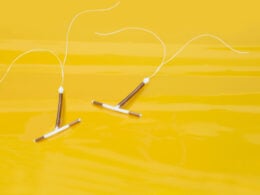If you’ve been following our e-newsletter, you know we have a lot of exciting plans for growth in 2020. But we would be remiss if we didn’t first acknowledge the challenges we faced and gains we made in 2019.
When it comes to women’s fertility health, there have been some troubling developments: 2019 has seen advertisements abound for longer-acting, “whoops-proof” birth control methods; websites that make it possible to receive birth control prescriptions without seeing a doctor; and guidelines that encourage birth control to be prescribed in bulk.
But at the same time, it was a huge year for critical coverage on birth control: Scientific American devoted an entire issue scrutinizing the Pill, and New York magazine’s website The Cut published an essay on why women are rejecting the Pill. In addition, the New York Times published a friendly article on fertility awareness. Women’s voices looking for better options are finally being heard.
Among the critical victories in 2019, we saw the CDC update its data on the effectiveness of Fertility Awareness-Based Methods (FABM). Natural Womanhood had spearheaded a petition for the CDC to change its erroneous figure that would mislead women to think FABM are unreliable forms of family planning, and now the CDC website acknowledges that certain methods of natural family planning can be as much as 98 percent effective in preventing pregnancy. The current site states FABM have a 2 to 23 percent failure rate, and while it doesn’t give a perfectly clear representation of the different types of FABM and effectiveness rates, it links to recent research and lends long-awaited legitimacy for Fertility Awareness-Based Methods as effective family planning options.
Accurate information on FABM is crucial today because too many women suffer side effects and health complications from pharmaceutical birth control. This was evidenced by another significant development in 2019—the Citizen’s Petition to the FDA to bring greater transparency of health risks to birth control prescribed patients.
Over the past year, Natural Womanhood took a closer look at a number of the health risks raised by the FDA petition’s documented research. Among them, we published articles on the connection between birth control and autoimmune diseases, including Lupus, Multiple Sclerosis (MS), and Crohn’s Disease; breast cancer and skin cancer; gallbladder disease; vision problems; decreased sex drive and depression.
We also published women’s personal accounts of complications from birth control, such as Cheyenne’s story of a toxic reaction to the copper IUD. We also shared women’s stories of mental illness symptoms on the Pill, stroke, migraines and weight gain, and other health complications, as well as augmenting the voices shared in the public comments of the FDA petition. We also published Anthony Williams’s personal account of his daughter Alexandra, who tragically died months prior due to birth-control related blood clots.
Natural Womanhood was the first outlet to break the stories of Alexandra’s and Cheyenne’s health complications from birth control. So it should not be a surprise that we remain at the forefront of encouraging greater awareness of FABM in medicine. We published a profile of an OBGYN who added FABM to her practice and an OBGYN physician assistant’s article on how charting is better for avoiding pregnancy than the Pill—even when you have a medical necessity to avoid pregnancy. In addition, we continue to equip readers to broach the topic with their less informed doctors.
Furthering our mission of improving women’s health, we published articles identifying how charting with fertility awareness methods can inform women’s fitness decisions, sleep health, and even Type 1 diabetes treatment plans. We offered clarity into how women can improve PMS symptoms through particular supplements and exercise; reminders of how menstruation is healthy for women; and how fertility awareness charting is better for irregular periods than birth control. We also shared how FABM assist women when it comes to improving mental health, from mood swings, to stress effects and self-care.
We talked about how we can better get ahead of doctors prescribing the Pill by educating our kids about FABM in the home and in schools. We shared articles combatting myths about teaching FABM to teens and equipping readers with new educational models such as Guiding Star’s Cycle Show.
The content at Natural Womanhood also provided clarity for even seasoned FABM supporters. We answered your questions about charting your cycle in perimenopause and the postpartum period, including information on the newest technologies that can assist with postpartum charting.
For those who are considering charting but don’t know where to start, we offered answers to questions such as: Can you chart while on the Pill? And how do you best transition from the Pill to FABM? We also covered how the popularity of charting apps shows women’s desires for more information about their cycles, what to know before using an app, and how having an instructor will help any app-user reach the highest effectiveness rates.
We recently received this comment from a reader:
“Thank you so much for what you do. I’ve used your website multiple times while I transitioned off birth control and have been using fertility awareness methods. The work you do is so important and can change the quality of so many women’s lives.”
This is why we do what we do.
It’s stunning how much ground we covered in just a year. Now is a crucial time to keep building momentum. If you appreciate the work we do, can you sign up now to make a recurring donation to help us through the year ahead? Or can you make an end-of-year donation to set us up for a strong start? It’s thanks to your support that we’ve made it this far, and we rely on your support to further our work.
So let’s cheers to what we’ve accomplished in 2019. And let’s start 2020 with fresh vigor. Here’s to a fruitful new year.











